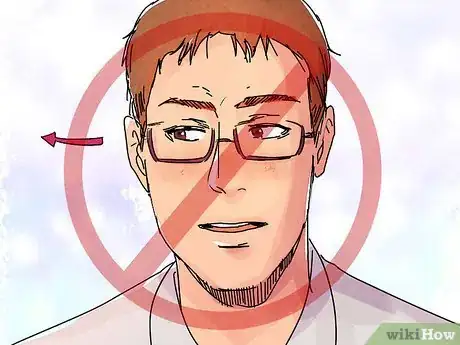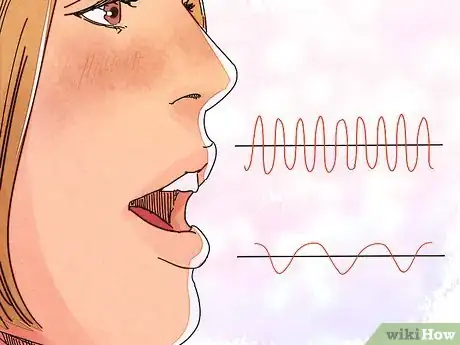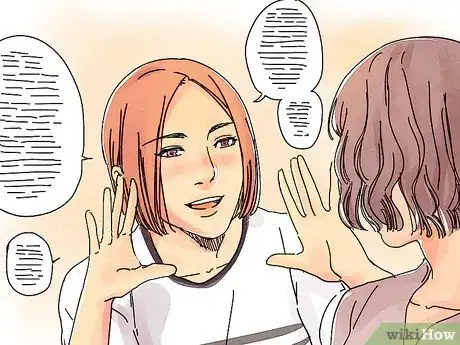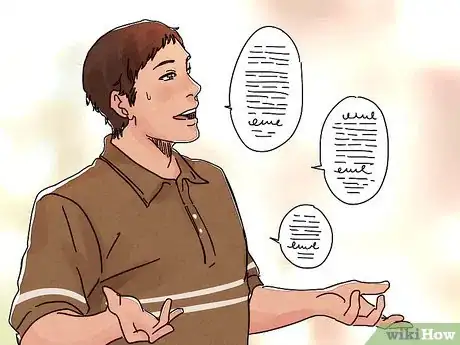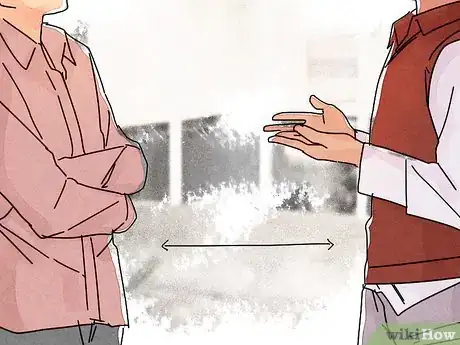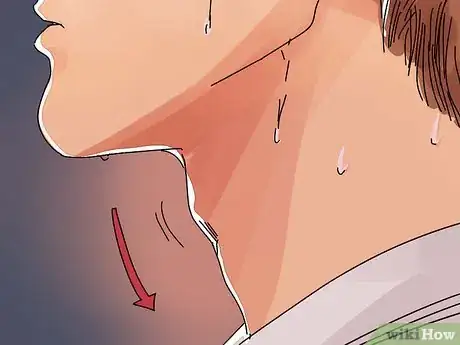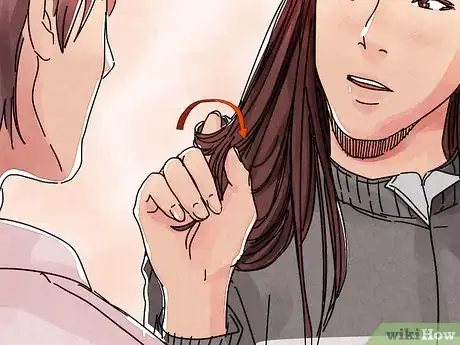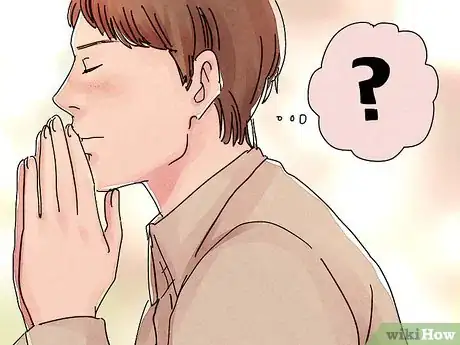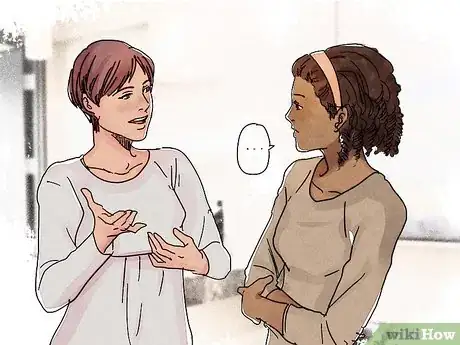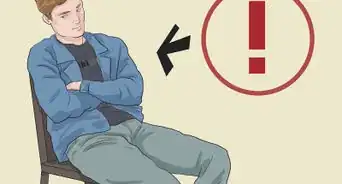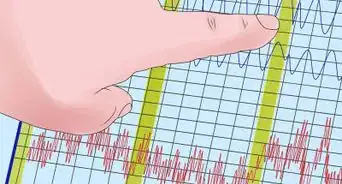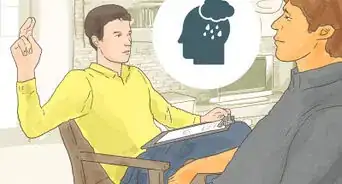This article was co-authored by Maya Diamond, MA and by wikiHow staff writer, Danielle Blinka, MA, MPA. Maya Diamond is a Dating and Relationship Coach in Berkeley, CA. She has 13 years of experience helping singles stuck in frustrating dating patterns find internal security, heal their past, and create healthy, loving, and lasting partnerships. She received her Master's in Somatic Psychology from the California Institute of Integral Studies in 2009.
wikiHow marks an article as reader-approved once it receives enough positive feedback. This article received 38 testimonials and 87% of readers who voted found it helpful, earning it our reader-approved status.
This article has been viewed 4,319,956 times.
Looking at the facial expressions of a person to determine whether or not they're lying might just save you from being a victim of fraud. Or it could help you know if it's safe to trust your heart and get involved with an attractive stranger. Jury analysts use lie detection when helping to select a jury; the police do it during interrogation. Even judges use lie detection to determine which side to rule in favor of. To use these techniques, you'll need to learn how to read the little facial and body expressions that most people don't notice. It takes a little practice but having this skill can be fascinating! To get started, read on...
Steps
Detecting Lies in the Face and Eyes
-
1Look for micro-expressions. Micro-expressions are facial expressions that flash on a person's face for a fraction of a second and reveal the person's true emotion, underneath the lie. Some people may be naturally sensitive to them, but almost anybody can train themselves to detect these micro-expressions.
- Typically, in a person who is lying, their micro-expression will be an emotion of distress, characterized by the eyebrows being drawn upwards towards the middle of the forehead, causing short lines to appear across the skin of the forehead.
-
2Look for nose touching and mouth covering. People tend to touch their nose more when they are lying.[1] This might be due to a rush of adrenaline to the capillaries in the nose, causing the nose to itch.[2] A lying person is more likely to cover their mouth with a hand or to place the hands near the mouth, as if they're covering up the lies. If the mouth appears tense and the lips are pursed, this can indicate distress.[3] [4]
- Listen for sniffles. Sometimes, touching the nose a lot just means that the person is having allergies, or fighting a cold.
Advertisement -
3Notice the person's eye movements. Sometimes you can tell if a person is remembering something or making something up based on eye movements. When people remember details, their eyes move up and to the left if they are left-handed. When right-handed people make something up, their eyes move up and to the right. People also tend to blink more rapidly ("eye flutter") as they're telling a lie. People (especially men) might rub their eyes more when they're lying.[1]
- Watch the eyelids. These tend to close longer than the usual blink when a person sees or hears something they don't agree with.[3] However, this can be a very minute change, so you will need to know how the person blinks normally during a non-stressful situation for accurate comparison. If the hands or fingers also go to the eyes, this may be another indicator of trying to "block out" the truth.[3]
- Be careful about relying on eye movements to catch a liar. Recent scientific studies have cast doubt on the idea that looking a certain direction can help pinpoint someone who is lying.[5] [6] Many scientists believe that eye directionality is a statistically poor indicator of truthfulness.
-
4Don't rely on eye contact to spot a liar. Contrary to popular belief, a liar does not always avoid eye contact.[1] They may naturally break eye contact and look at non-moving objects to help them focus and remember. Liars may deliberately make eye contact to seem more sincere; this can be practiced to overcome any discomfort, as a way of "proving" that truth is being told.
Detecting Lies in Verbal Responses
-
1Notice if the person's voice changes. They may suddenly start talking faster or slower than normal, or the tension may result in a higher-pitched or quavering tone. They may start stuttering or stammering, when they usually don't. If their voice is different from normal, it might be a sign of a lie.
-
2Pay attention to exaggerated details. See if the person appears to be telling you too much. An example might be, "My mom is living in France, isn't it nice there? Don't you like the Eiffel tower? It's so clean there." Too many details may tip you off to the person's desperation to get you to believe what is being said.
-
3Be aware of impulsive emotional responses. Timing and duration tends to be off when someone is lying. It's either because the person in question has rehearsed their answer (or is expecting to be questioned) or rattles off something, anything, in order to fill the silence.
- If you ask someone a question and the person responds right away, it might be a lie. This can be because the liar has rehearsed the answer or is already thinking about the answer just to get it over with.
- Another tell can be omission of relevant time facts, such as saying "I went to work at 5 AM and when I got home at 5 PM, he was not there." In this glib example, what happened in between has been all too conveniently glided over.[7]
-
4Pay close attention to the person's reaction to your questions. Someone who has told the truth doesn't feel much need to defend themselves, well, because they're telling the truth. Someone who hasn't told the truth needs to compensate for their lie by perhaps going on the offensive, deflecting, or another stalling tactic.
- If you question their story, a truthful person will often give you more details. A liar is more likely to just repeat what they already said, because they don't want to make their story even more complicated.[4]
- Listen for a subtle delay in responses to questions. An honest answer comes quickly from memory. Lies require a quick mental review of what they have told others to avoid inconsistency and to make up new details as needed. Note that when people look up to remember things, it does not necessarily mean that they're lying — this could just be a natural instinct.
-
5Look for unusual wording. The ways someone speaks may be able to give you hints. If they're speaking differently than usual, it is possible that they're telling you a lie.
- No contractions. A liar may avoid contractions, like saying "I did not do it" instead of "I didn't do it." This is an attempt to make it absolutely clear what the liar means.[3]
- Short answers. Some liars give the shortest possible answers they can (like "Yes" or "No"), to avoid giving away extra details.
- Run-on sentences. A liar may speak in muddled or unclear sentences. They often stop mid-sentence, restart and fail to finish sentences.[4]
- Claiming honesty. Liars might say things like "to be honest," "frankly," "to be perfectly truthful," "I was brought up to never lie," etc. Honest people don't usually spend much time calling themselves honest.[3]
- Throwing it back at you. If you ask "Did you ___," they may immediately reply "No, I did not ____." This is an attempt to avoid the impression of a delayed answer.[3]
-
6Look at stalling and distraction techniques[8] . A liar may try to stall or distract you, to give them more time to think up a believable story.[3]
- Repeating your own exact words when answering a question.
- Asking you to repeat the question.
- Praising you, like saying "Good question!" or "How did you get to be such a good investigator?"
- Acting confrontational, like saying "It depends on what you mean by that" or "Where did you get this information?
- Using humor or sarcasm to avoid the subject.[9]
-
7Notice when the person repeats sentences. If the suspect uses almost the exact same words over and over, then it's probably a lie. When a person makes up a lie, he or she often tries to remember a certain phrase or sentence that sounds convincing. When asked to explain the situation again, the liar will use the very same "convincing" sentence again.
-
8Notice the mid-sentence jump. The mid-sentence jump is when a clever liar tries to distract attention away from him or herself by interrupting themselves mid-stream and talking about something else. Someone might try to change the subject in this clever way: "I was going — Hey, did you get a new haircut this weekend?"
- Be especially cautious of compliments from the subject in question. The liar knows that people respond well to compliments, giving him or her a chance to escape interrogation by complimenting someone. Be wary of someone who delivers a compliment out of the blue.
Detecting Lies in Body Language Tics
-
1Check for sweating. People tend to sweat more when they lie.[10] Measuring sweat is one of the ways that the polygraph test (the "lie detector" in all the movies) determines a lie. Sweating is sometimes, but not always, a sign of lying.
- Remember that this isn't a reliable sign. Sweating could mean that the person is nervous or shy. They also could have been exercising recently, or have a health condition that causes more sweating. Look for other signs too.
-
2Watch when the person nods or shakes their head. Sometimes, the person's mouth lies, but their head tells you the truth. This is called "incongruence." The person probably does not realize they are doing it.
- For example, if your husband says "I scrubbed those pots really hard," but he's shaking his head, then he probably did not scrub them well.[1] [3]
- Notice any pauses. A truthful person tends to nod at the same time as they tell the truth; a liar may need to remind themselves to nod (and thus not do it right away).[1]
-
3Watch for fidgeting. Sometimes liars fidget more than usual, because they have nervous energy and fear being found out. In order to release the nervous energy, liars often fidget with a chair, a handkerchief, or a part of their body.
- Fidgeting can also be a sign of awkwardness, restlessness, discomfort, or a need to use the toilet.
- People with disabilities like ADHD or autism may fidget a lot. This doesn't mean anything about honesty; it's just how they stay comfortable.
- Stillness doesn't always mean honesty. Some liars stand or sit very still because they are so focused on their lie.
-
4Observe the level of mirroring. People naturally mirror the behavior of others with whom they're interacting. It's a way of establishing rapport and showing interest. When lying, mirroring may drop, as the liar spends a lot of effort on creating another reality for the listener. Some examples of failed mirroring that might alert you that something's not right:
- Look at leaning. Leaning away is a sign of discomfort, dislike, or disinterest. A liar may lean away from you, not wanting to give out any more information than they need to.[3] An honest person is more likely to lean toward you (unless you're making them uncomfortable).
- See if they are unusually still. Lying requires focus, so some liars will sit or stand very still, because all their mental energy is going towards telling a convincing lie.
-
5Watch the person's throat. A person may constantly be trying to lubricate their throat when they lie by swallowing, gulping or clearing their throat. Lying causes their body to increase production of adrenaline, which gets their saliva pumping and then creates very little. While the saliva is surging, the subject might be gulping it down. When the saliva is no longer surging, the subject might be clearing their throat.
-
6Check the person's breathing. A liar tends to breathe faster, displaying a series of short breaths followed by one deep breath.[3] The mouth may appear dry (causing much throat clearing). Again, this is because they are putting their body through stress, which causes the heart to beat faster and the lungs to demand more air.
-
7Notice the behavior of other body parts. Watch the person's hands, arms and legs. In a non-stressful situation, people tend to be comfortable and take up space by being expansive in hand and arm movements, perhaps sprawling their legs comfortably. In a lying person, these parts of the body will tend to be limited, stiff, and self-directed.[3] The person's hands may touch his or her face, ear, or the back of the neck. Folded arms, interlocked legs and lack of hand movements can be a sign of not wanting to give away information.
- Liars tend to avoid hand gestures that we consider a normal part of discussion or conversation. With some caveats, most liars will avoid finger pointing, open palm gestures, steepling (fingertips touching each other in a triangle shape often associated with thinking out loud), etc.[3]
- Check the knuckles. Liars who stay motionless may grip the sides of a chair or other object until the knuckles turn white, not even noticing what's happening.[3]
- Grooming behaviors are common in liars, such as playing with hair, adjusting a tie, or fidgeting with a shirt cuff.[4] [11]
- Two caveats to remember:
- Liars can deliberately slouch to appear "at ease".[3] Yawning and bored behavior may be a sign of trying to act just a little casual about the situation so as to cover up deception. Just because they're at ease doesn't mean they're not lying.
- Keep in mind that these signals may be a sign of nervousness and not a sign of deceit. The subject in question might not necessarily be nervous because they're lying.
-
8Keep in mind that there may be other reasons for unusual body language. Different body language doesn't always signal dishonesty. Avoid jumping to conclusions, because there might be many reasons why someone acts different. These include...
- Coming from a different culture, with different norms related to body language
- Feeling nervous for a reason not related to dishonesty (like being shy, or having social anxiety)
- Feeling cold (and thus crossing their arms and seeming "closed up")
- Having a disability that impacts body language, like ADHD or autism (which may involve fidgeting, odd body language, and staring or avoidance of eye contact)
Detecting Lies Through Interrogation
-
1Be careful. Although it is possible to detect dishonesty and lying, it is also possible to misread deception where there is none. A stressed person can be easily mistaken for a liar, as some of the signs of stress can look like signs of lying. Thus, you should look for many signs that the person is lying, instead of only drawing a conclusion based on one or two signs.[3] Sometimes, people may seem dishonest, when they're actually just dealing with...
- Embarrassment
- Shyness
- Awkwardness
- Feeling ashamed or inferior
- Stress
-
2Take time to establish rapport with the alleged liar and create a relaxed atmosphere. This includes not showing any signs that you suspect the other person of lying, and making an effort to mirror their body language and pace of conversation. When questioning the person, act in an understanding, not overbearing, manner. This approach will help to let down the other person's guard and can help you to read the signs more clearly.
-
3Establish a baseline. A baseline is how someone behaves when they aren't lying. This will help you tell if the way the person is acting currently is any different from how they usually act. Begin by getting to know the person if you don't already and proceed from there — people usually answer basic questions about themselves truthfully. For someone you already know, checking for a baseline might include asking the person about something the answer of which you already know.
-
4Learn to spot deflections. Usually, when people are lying, they will tell stories that are true, but are deliberately aimed at not answering the question you asked. If a person is trying to trick you, they may not answer your question directly. They may answer the question that they wish you had asked. This may indicate that they're lying or trying to conceal something from you.
- If asked "Did you ever hit your wife?", a liar might say "I love my wife. Why would I do that?" That answer might technically be the truth, but they've avoided the question. (Someone with nothing to hide will likely answer the question directly, like by saying "No! Never!")
-
5Ask the person to repeat the story over again. If you're really not sure whether they're telling the truth, ask them to repeat the story multiple times. It's hard to keep track of information that isn't truthful. In the process of repeating their made-up story, the liar is likely to say something inconsistent, outright false, or telling.
- Ask the person to tell the story backwards.[4] This is very hard to do, especially when requiring no loss of the details. Even a professional liar can find this reversal of approach a hard one to tackle effectively.
-
6Stare at the alleged liar with a look of disbelief. A liar usually gets uncomfortable when you do this. An honest person usually becomes angry or frustrated (lips pressed together, brows down, upper eyelid tensed and pulled down to glare).
-
7Use silence. A liar usually wants to fill the silence, because it makes them nervous.[3] They want you to believe the lies being woven; silence gives no feedback on whether or not you've bought the story. By being patient and remaining silent, many deceitful people will keep talking to fill that silence, embellishing and possibly slipping up in the process, without even being asked anything!
- Liars try to read you to see if you've bought the tale.[4] If you don't show any signs of something to monitor, many liars will feel uncomfortable.
- If you're a good listener, you'll already be avoiding interruptions, which in itself is a great technique to let the story unfold. Practice not interrupting others if you have this tendency — not only will it help you to detect lies, but it'll make you a better listener generally.
Reflecting on the Situation
-
1Look at the big picture. When assessing the body language, verbal responses and other indicators indicative of lying, consider factors such as:[1]
- Is the person unduly stressed in general, not just from the current situation?
- Is there a cultural factor involved? Perhaps the behavior is culturally appropriate in one culture, but is seen as dishonest behavior in another.
- Does the person have a disability that might impact their body language?
- Are you personally biased or prejudiced against this person? Do you want this person to be lying? Be careful of falling into this trap!
- Is there a history of this person lying? Namely, are they experienced at it?
- Is there a motive, and do you have a good reason for suspecting lying?
- Are you actually any good at reading lies? Have you taken into account the entire context and not simply zoomed in on one or two possible indicators?
-
2Reflect on your own behavior. Do you often suspect or accuse people of lying? This could be a sign that you have trouble trusting other people. If you're always on the offensive, people may have a hard time liking you or getting close to you.
- Consider talking to a counselor if you struggle to trust or relax around other people.
-
3Be careful about making accusations against your loved ones. If you wrongly accuse someone of lying, you could damage or destroy a relationship. You could also harm your reputation, and people may think that they might wrongly accuse you. Make certain that you are sure about a lie before you call someone on it.
- Avoid jumping to conclusions based on reputation. If someone has lied before, they may be doing it again. But they may also be turning over a new leaf, or be being framed by someone who figures that they'll be easy to blame.
-
4Follow through.[12] If you have the means, check out the facts behind what the liar is saying. A skilled liar might give some reason why you shouldn't talk to the person who could confirm or deny a story. These are probably lies themselves, so it might be worthwhile overcoming your reluctance and to check with the person you've been warned against. Anything factual that can be checked should be checked.
- Check if the lie makes sense. Is it logical, or are there parts that don't seem realistic?
Expert Q&A
Did you know you can get expert answers for this article?
Unlock expert answers by supporting wikiHow
-
QuestionHow do you outsmart a liar?
 Maya Diamond, MAMaya Diamond is a Dating and Relationship Coach in Berkeley, CA. She has 13 years of experience helping singles stuck in frustrating dating patterns find internal security, heal their past, and create healthy, loving, and lasting partnerships. She received her Master's in Somatic Psychology from the California Institute of Integral Studies in 2009.
Maya Diamond, MAMaya Diamond is a Dating and Relationship Coach in Berkeley, CA. She has 13 years of experience helping singles stuck in frustrating dating patterns find internal security, heal their past, and create healthy, loving, and lasting partnerships. She received her Master's in Somatic Psychology from the California Institute of Integral Studies in 2009.
Life Coach
-
QuestionHow do you confront someone about lying?
 Maya Diamond, MAMaya Diamond is a Dating and Relationship Coach in Berkeley, CA. She has 13 years of experience helping singles stuck in frustrating dating patterns find internal security, heal their past, and create healthy, loving, and lasting partnerships. She received her Master's in Somatic Psychology from the California Institute of Integral Studies in 2009.
Maya Diamond, MAMaya Diamond is a Dating and Relationship Coach in Berkeley, CA. She has 13 years of experience helping singles stuck in frustrating dating patterns find internal security, heal their past, and create healthy, loving, and lasting partnerships. She received her Master's in Somatic Psychology from the California Institute of Integral Studies in 2009.
Life Coach
-
QuestionWhy do liars feel stress when there is silence?
 Community AnswerSilence makes them feel like their message hasn't been accepted by the person they are talking to.
Community AnswerSilence makes them feel like their message hasn't been accepted by the person they are talking to.
Warnings
- Studies show that interrogations of a suspected liar should always be performed in their mother tongue as even expert speakers of a foreign language will not show the same reactions (in spoken language as well as body language) if questioned in a language acquired later in life.⧼thumbs_response⧽
- Some people have really dry throats and will naturally swallow and clear their throats often.⧼thumbs_response⧽
- Be aware that some people like to stare at you eye-to-eye. They may have trained themselves to do this, they may use it as a way to put others on edge or they might just think it's being polite because someone told them to maintain eye contact as a matter of courtesy!⧼thumbs_response⧽
- Forcing a smile is often just an attempt to be polite; don't take this personally. If someone fakes a smile for you, it can also mean that he or she wants to make a good impression on you, valuing you as a person and showing respect.⧼thumbs_response⧽
- Be aware of disabilities. A disability can affect the way someone interacts, so applying non-disabled standards could lead to misinterpretation. Find how they normally act, and then notice deviations from that.
- Autistic people (including those with Asperger's) may fidget and avoid eye contact as part of their natural body language.
- Anxiety (notably social anxiety and PTSD) can sometimes look like lying; a person may avoid eye contact, avoid people, and act nervous.
- Deaf or hard of hearing people may need to watch your mouth instead of your eyes in order to lip read or better understand what you are saying.
- Bipolar (manic depression) symptoms include fast talking during a manic phase.
⧼thumbs_response⧽
References
- ↑ 1.01.11.21.31.41.5Martin Soorjoo, The Black Book of Lie Detection, http://www.customerexpressions.com/cex/cexweb.nsf/%28GetPages2%29/Effective-Lie-Detection-Techniques, retrieved July 24, 2012
- ↑ http://www.forbes.com/sites/carolkinseygoman/2012/04/11/12-ways-to-spot-a-liar-at-work/2/
- ↑ 4.04.14.24.34.44.5Stuart Wolpert, How to Tell When Someone's Lying, http://newsroom.ucla.edu/portal/ucla/how-to-tell-when-someone-s-lying-202644.aspx, retrieved July 24, 2012
- ↑ http://www.dailymail.co.uk/sciencetech/article-2172119/Lying-eyes-myth--looking-right-DOESNT-mean-fibbing-say-scientists-video-study.html
- ↑ http://healthland.time.com/2012/07/13/is-that-a-bluff-looking-for-lies-in-peoples-shifty-eyes/
- ↑ Maria Avgitidis. Matchmaker & Dating Expert. Expert Interview. 20 December 2019.
- ↑ Maria Avgitidis. Matchmaker & Dating Expert. Expert Interview. 20 December 2019.
- ↑ Maria Avgitidis. Matchmaker & Dating Expert. Expert Interview. 20 December 2019.
- ↑ https://time.com/5443204/signs-lying-body-language-experts/
- ↑ http://www.forbes.com/sites/susanadams/2012/08/13/how-to-tell-when-someone-is-lying/
- ↑ Maria Avgitidis. Matchmaker & Dating Expert. Expert Interview. 20 December 2019.
About This Article
To detect if someone is lying, watch to see if they touch their nose or cover their mouth while they're talking, which could be a sign that they're not telling the truth. Also, listen carefully to the person's voice. If it's higher-pitched or if they're stuttering and stammering a lot, it could mean they're lying to you. You can also keep an eye out for physical signs of nervousness, like sweating, fidgeting, or fast breathing, which may indicate that they're nervous because they're hiding something. To learn how to tell if someone is lying based on what they're saying, scroll down!



